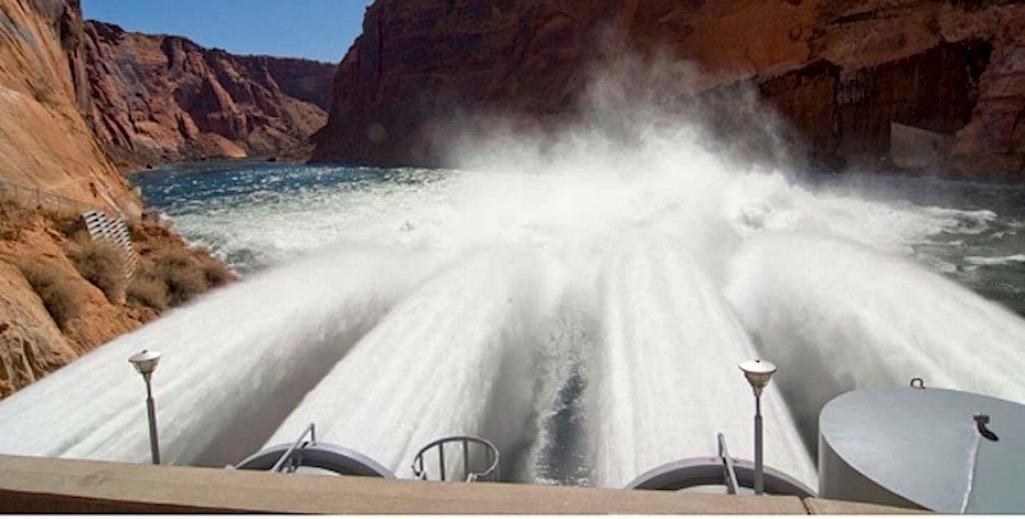
High flows will be released from Glen Canyon Dam into the Colorado River as it runs through Grand Canyon National Park/NPS file
The Colorado River will be rocking and rolling through Grand Canyon National Park later this month as a "spring disturbance flow" is released from Glen Canyon Dam upstream.
The release is set for March 15 to 26. The operation will coincide with required maintenance on the concrete apron downstream of the dam and powerplant. The spring disturbance flow will not affect the monthly or annual release volumes from Lake Powell.
Lake Powell releases through Glen Canyon Dam will be reduced to 4,000 cubic feet per second beginning March 15. Flows will begin a gradual increase on March 20, will peak at 20,150 cfs on March 22 and will remain steady at that level until March 25. Typical flows in March range from a daily low of 8,000 cfs to daily highs around 15,000 cfs.
Standard operations will resume on the morning of March 26.
The disturbance flows are designed to simulate a spring-timed runoff event. As the changing flows disturb river bottom habitats, ecosystem responses may include elevated algae and insect production resulting in increased aquatic insect prey for endangered humpback chub, non-native rainbow trout, and other wildlife.
The flows also may affect the non-native brown trout in Glen Canyon by reducing survival of emerging young, which may help protect native fish in the river. Scientists will study the effects of the modified flows in Glen, Marble, and Grand canyons and the resulting data may be used to make future recommendations on how to better support the Colorado River ecosystem.
"Scientific studies like these are an important part of our obligation to effectively balance the need for water and power resources with responsible stewardship of the Colorado River ecosystem," said U.S. Bureau of Reclamation's Upper Colorado Basin Regional Director Wayne Pullan. "This spring disturbance flow was developed and proposed by agency experts from the Bureau of Reclamation, U.S. Geological Survey, and Western Area Power Administration in close collaboration with Colorado River stakeholders, with strong support from environmental and recreational interests. I applaud the partnership and collaboration of the Glen Canyon Dam Adaptive Management Work Group, including all seven basin states and five Native American tribes, to continue our successful adaptive approach to managing Glen Canyon Dam."
Additional information about this release will be posted and updated online at: https://www.usbr.gov/uc/progact/amp/DisturbanceFlow.html



Comments
Thank you at least someone understood what I was saying
Why even worry about this problem? Didnt the people in power now like AOC say that we only have 12 years to live because of global warming ? I say run up your credit cards and empty your bank accounts.going fishing and renting large houseboats on lake powel and lake mead because.very soon it will all be over. Having experienced this big flow the last time it is good for the rebuilding of sandbars and riparian areas...however we are in a very serious drought and maybe we should hold off dumping water down to the gulf at this time.
Good post.
Lots of people care about the native fish.not just for the sake of helping reduce our impact on the environment, but also to learn from fish that have adapted to drough conditions. If you want trout, go upstream to the mountains where they are there naturally and in huge quantities.
Because of the amount of water lost in the colorado river basin as well as lake Powell and mead to evaporation, these lakes will likely never be full again. It's worth it to read up on water in the west. We've been in a prolonged drought since 2000
There's a timely article on this topic on page A2 of this morning's Bozeman Daily Chronicle. According to the article, it's going to be a real water law brawl with everyone behaving as selfishly as possible and Utah predictably setting the fake moral tone, business as usual in the American West.
National Park Traveler your title is misleading, high flows? This is essentially a low flow event. Flows Over 20000cfs have been typical summer release flows for over 20 years now. In the month of March that flow regime is only about 5000 cfs over the average high flow. The low flow of 4000cfs is the real story here! And 4000cfs will be more challenging and require more skill in many rapids than rapids at the 20000cfs flows! 4000cfs has not been seen since probably the the 1980's. 20K is NOT a high flow! Writers should really research and pay attention more before writing articles and then slapping on click bait titles!
Maybe do a little reserch here before writing an article. 20k cfs is not high flows. The title might be low flows coming to the Grand Canyon.